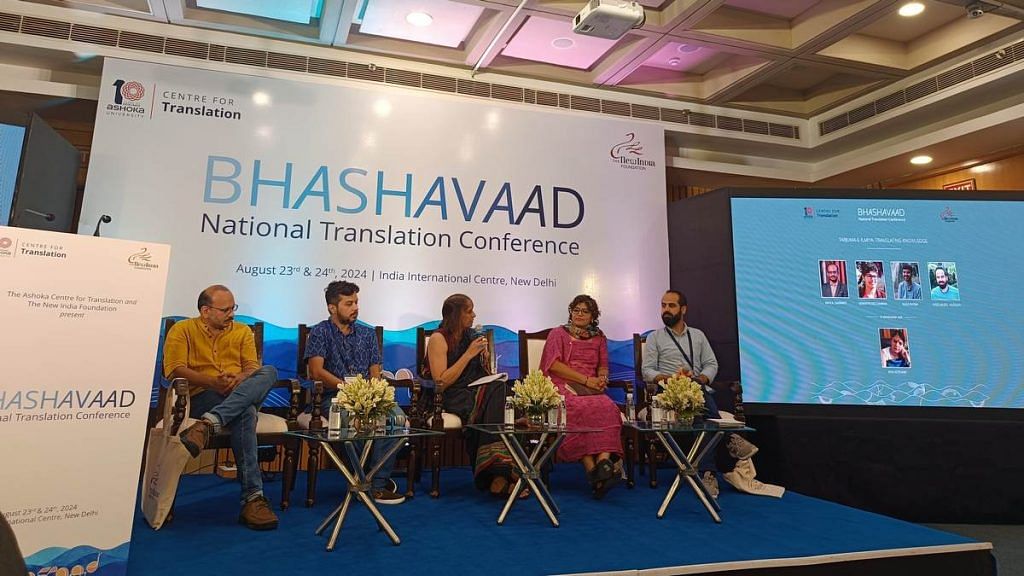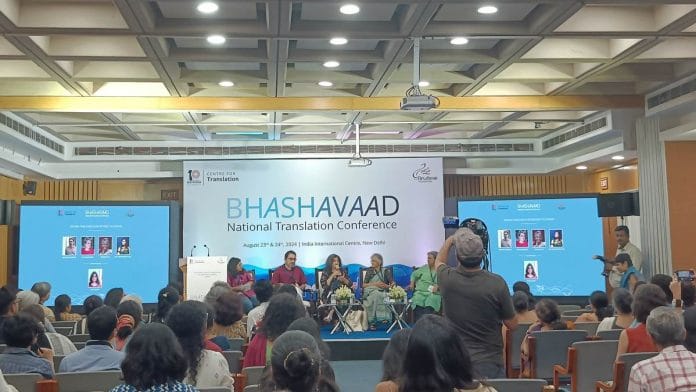New Delhi: In India, English is often used as a link language between different regional languages. But it’s very rare for regional languages to play this role. Indian languages, in a sense, don’t speak to each other. Even in translations, English often acts as a ‘filter’ between, say, a Hindi book and its version in a South Indian language.
“Why don’t we translate directly from Telugu into Odia or other Indian languages? This question has always bothered me,” said Jatin Nayak, a noted Odia translator and former professor during ‘Bhashavaad’, the first National Translation Conference hosted by Ashoka University at Delhi’s India International Centre (IIC) on 23-24 August. He added that it’s almost like a feud between neighbours or relatives—where close ties exist but meaningful exchanges are rare.
Over two days, ‘Bhashavaad’, which roughly translates to ‘language exchange’ in Hindi, explored this and other themes in Indian translations. The conference drew a large audience of university students, professors, historians, and linguists who came to hear the thought-provoking discussions on the evolving role of translators, transcending the binaries of source and target languages, as well as the shifting cultural and literary sensibilities within and beyond Indian languages.
Nayak’s remarks came during a session in the conference’s second day, titled Xabd Setu: Writing in and Between the Bhashas, moderated by Srinath Raghavan, a professor of history and international relations at Ashoka University. He asked Nayak how contact between different languages could be improved.
In response, Nayak pointed out that Odisha was the first province in India to be formed on the basis of language. During the Odia identity movement in the 19th century, many journals flourished—but stayed cut off from other regional languages.
“We translated stories from English, but there wasn’t a single translation from Hindi, Bengali or Telugu because we were trying to celebrate our isolation, that we are unique,” Nayak said. He added that while most regional languages have thrived as mediums of entertainment, they have largely failed to develop as languages of knowledge.
Dissent over ‘Bhashavaad’
Not everyone was pleased with the conference title. Gita Ramaswamy, a Telugu publisher, argued that it was too Hindi-centric and risked alienating others.
“It is like very Hindi and sort of puts the backs of all South Indians up,” she said to laughter at another session titled Antaram: Publishing in and Between the Bhashas, moderated by Neeta Gupta, chief editor of Anuvad, the quarterly journal of the Bharatiya Anuvad Parishad (Indian Translators’ Association).
In the same session, Gupta raised the issue of the high cost of translations. Aditi Maheshwari Goyal, who runs the leading Hindi publishing house Vani Prakashan, agreed that the art and commerce of translation are often at odds, but also stressed that getting the right translator for a work is of paramount importance.
“A translator can have an excellent flair in poetry, but if a non-fiction book is given to them, it can go through disasters. So, a good matchmaker is very important,” Goyal said.
As a publisher, Goyal also spoke about the challenges of ascertaining commercial viability.
“Translation is no less than a gamble sometimes,” she said, adding that it’s very disheartening that publishers from other languages often base their decisions on Amazon listings.
“Sometimes, true gems do not fare well on Amazon,” she said, noting that this shouldn’t be the only measure of a book’s worth.
Translation as ‘conquest’
The complex interplay between translation and the creation of knowledge formed the crux of a session titled Tarjuma-e-Ilmiya: Translating Knowledge.
“The question is, does translation create new knowledge?” asked moderator Rita Kothari, professor of English and co-director of the Ashoka Centre for Translation.

Kothari also explored the history of translation as a tool of “conquest” from the Mughal era to the colonial period. During the time of the Mughals, she said, translation bureaus were established to convert texts from Sanskrit to Persian. In colonial times, orientalist scholars such as William Jones were involved in translating Sanskrit works into English. This contributed to a vast body of knowledge—though not without gaps in understanding.
One of the panelists, conservationist and wildlife historian Raza Kazmi, discussed how translation has shaped his field. He said that 95 per cent of the writings about conservation and wildlife were produced by the British during the colonial period, creating an incredible body of knowledge.
“But their limitation was that they were looking at the forest and the people who lived around them from their own gaze,” he said. “I was quite interested in looking into literature around forests in Indian languages to see how different classes, castes and religions saw the forests.”
In this quest, Kazmi said he discovered valuable works in Urdu, Bengali, Marathi, Kannada, Gujarati, and Hindi, often written by junior-rank forest officers.
“Because they spoke the language, they could communicate directly with the people, pick up on a lot of nuances that the British would miss,” he said.
These writings, according to Kazmi, never described the jungle as threatening and tended to take a more nuanced view than translations.
“The vocabulary for the forest is very regional language specific,” Kazmi said. “Folk songs and couplets are peculiar things when locals write about the forests and this is found across the languages.”
In this session, Kothari offered a metaphor for the act of translation, comparing it to “parkaya pravesh” (alien entry).
“Translation is like entering into a body,” she said. “It might lead to an exploitative and a fairly invasive gesture.”
(Edited by Asavari Singh)







How come Bhashavad roughly translates to language translation. Like स्त्रीवाद, समाजवाद, etc, vaad should be “ism” and therefore Bhashavad means linguism. Just because you are writing in English, doesn’t mean you are correct. You should have analysed the word or consulted a dictionary.